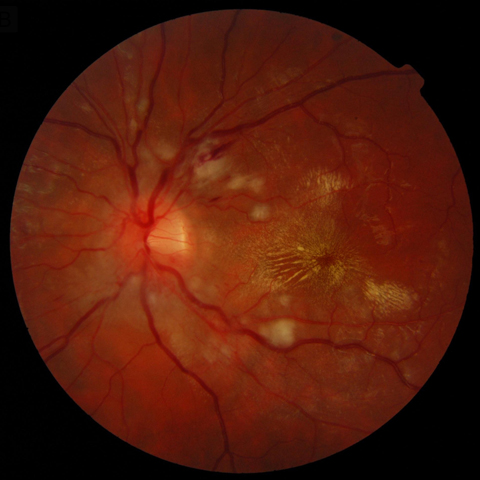A 14-year-old girl with intermittent headache, palpitations, tachycardia, and diaphoresis
Main Article Content
Abstract
Pheochromocytomas are neuroendocrine tumors originating from chromaffin cells. Most arise from the adrenal medulla, while approximately one out of ten cases originate from the extra-adrenal paraganglia. These catecholamine-secreting tumors cause a broad spectrum of symptoms and may resemble various clinical disorders. Their clinical picture varies greatly, from the classic triad of headaches, diaphoresis and palpitations, to asymptomatic tumors discovered incidentally on imaging. We present the case of a 14-year-old girl with pheochromocytoma of adrenal origin and grade IV hypertensive retinopathy and review the clinical picture, follow-up examination, molecular findings and outcome of the 11 reported cases of pheochromocytoma and hypertensive retinopathy in children.
Downloads
Article Details

This work is licensed under a Creative Commons Attribution-NonCommercial-NoDerivatives 4.0 International License.
References
Rimoldi SF, Scherrer U, Messerli FH. Secondary arterial hypertension: when, who, and how to screen? Eur Heart J 2014;35:1245-54. DOI: https://doi.org/10.1093/eurheartj/eht534
Zuber SM, Kantorovich V, Pacak K. Hypertension in pheochromocytoma: characteristics and treatment. Endocrinol Metab Clin North Am 2011;40:295-311. DOI: https://doi.org/10.1016/j.ecl.2011.02.002
Marik PE, Varon J. Hypertensive crises: challenges and management. Chest 2007;131:1949-62. DOI: https://doi.org/10.1378/chest.06-2490
Williams B, Mancia G, Spiering W, et al. 2018 ESC/ESH guidelines for the management of arterial hypertension. Eur Heart J 2018;39:3021-104. DOI: https://doi.org/10.1093/eurheartj/ehy439
Chen TY, Liang CD, Shieh CS, et al. Reversible hypertensive retinopathy in a child with bilateral pheochromocytoma after tumor resection. J Formos Med Assoc 2000;99:945-7.
Naqiyah I, Rohaizak M, Meah FA, et al. Phaeochromocytoma of the urinary bladder. Singapore Med J 2005;46:344-6.
Brandenburg VM, Schrage N. Hypertensive retinopathy. Wien Klin Wochenschr 2005;117:187. DOI: https://doi.org/10.1007/s00508-005-0325-z
I-Linn ZL, Long QB. An unusual cause of acute bilateral optic disk swelling with macular star in a 9-year-old girl. J Pediatr Ophthalmol Strabismus 2007;44:245-7. DOI: https://doi.org/10.3928/01913913-20070701-06
Sanjay KM, Partha PC. The posterior reversible encephalopathy syndrome. Indian J Pediatr 2008;75:953-5. DOI: https://doi.org/10.1007/s12098-008-0168-5
Tibbetts MD, Wise R, Forbes B, et al. Hypertensive retinopathy in a child caused by pheochromocytoma: Identification after a failed school vision screening. J AAPOS 2012;16:97-9. DOI: https://doi.org/10.1016/j.jaapos.2011.09.010
Shah V, Zlotcavitch L, Herro AM, et al. Bilateral papillopathy as a presenting sign of pheochromocytoma associated with von Hippel-Lindau disease. Clin Ophthalmol 2014;8:623-8. DOI: https://doi.org/10.2147/OPTH.S60725
Alface MM, Moniz P, Jesus S, Fonseca C. Pheochromocytoma: clinical review based on a rare case in adolescence. BMJ Case Rep 2015;2015:bcr2015211184. DOI: https://doi.org/10.1136/bcr-2015-211184
Ramareddy R, Alladi A. Adrenal mass: unusual presentation and outcome. Indian J Med Paediatr Oncol 2017;38:256-60. DOI: https://doi.org/10.4103/ijmpo.ijmpo_33_16
Jayarajah U, Herath KB, Fernando MH, Goonewardena S. Phaeochromocytoma of the urinary bladder presenting with malignant hypertension and hypertensive retinopathy. Asian J Urol 2020;7:70-2. DOI: https://doi.org/10.1016/j.ajur.2019.05.002
Nair A, Vijayaraghavan A, Alexander P, et al. More than it meets the eye! Vision loss as a presenting symptom of von Hippel–Lindau disease. J Pediatr Neurosci 2020;15:314. DOI: https://doi.org/10.4103/jpn.JPN_24_20
Rabi DM, McBrien KA, Sapir-Pichhadze R, et al. Hypertension Canada’s 2020 comprehensive guidelines for the prevention, diagnosis, risk assessment, and treatment of hypertension in adults and children. Can J Cardiol 2020;36:596-624. DOI: https://doi.org/10.1016/j.cjca.2020.02.086
Peixoto AJ. Acute severe hypertension. N Engl J Med 2019;381:1843-52. DOI: https://doi.org/10.1056/NEJMcp1901117
Browning AC, Mengher LS, Gregson RM, Amoaku WM. Visual outcome of malignant hypertension in young people. Arch Dis Child 2001;85:401-3. DOI: https://doi.org/10.1136/adc.85.5.401
Favier J, Amar L, Gimenez-Roqueplo AP. Paraganglioma and phaeochromocytoma: From genetics to personalized medicine. Nat Rev Endocrinol 2015;11:101-11. DOI: https://doi.org/10.1038/nrendo.2014.188
Neumann HPH, Young WF, Eng C. Pheochromocytoma and Paraganglioma. N Engl J Med 2019;381:552-65. DOI: https://doi.org/10.1056/NEJMra1806651
Unger T, Borghi C, Charchar F, et al. 2020 International society of hypertension global hypertension practice guidelines. Hypertension 2020;75:1334-57. DOI: https://doi.org/10.1161/HYPERTENSIONAHA.120.15026




